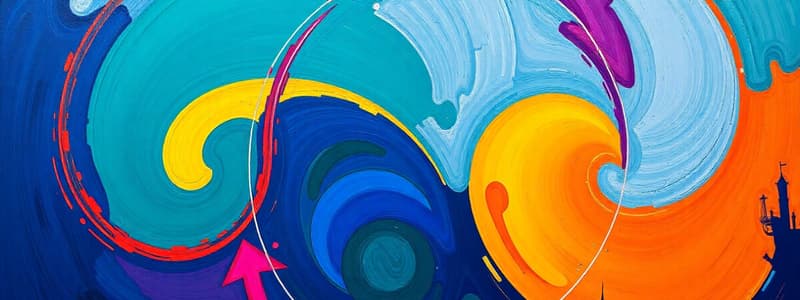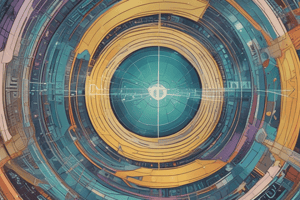Podcast
Questions and Answers
In the circular flow model, households primarily function as consumers of goods and services while also providing labor resources.
In the circular flow model, households primarily function as consumers of goods and services while also providing labor resources.
True (A)
Firms, within the circular flow model, are responsible for providing goods and services, utilizing labor, and disbursing profits exclusively to the government.
Firms, within the circular flow model, are responsible for providing goods and services, utilizing labor, and disbursing profits exclusively to the government.
False (B)
The government's role in the circular flow model is limited to collecting taxes and has no involvement in providing public services or directly regulating the economy.
The government's role in the circular flow model is limited to collecting taxes and has no involvement in providing public services or directly regulating the economy.
False (B)
In the circular flow model, the foreign sector solely involves the export of goods and services from a country, without any imports.
In the circular flow model, the foreign sector solely involves the export of goods and services from a country, without any imports.
Real flow in the circular flow pertains exclusively to financial transactions, such as wages paid to workers and consumer spending on goods.
Real flow in the circular flow pertains exclusively to financial transactions, such as wages paid to workers and consumer spending on goods.
Saving money is considered an injection into the economy because it increases the funds available for investment.
Saving money is considered an injection into the economy because it increases the funds available for investment.
According to the circular flow model, if total leakages exceed total injections, the economy is likely to experience a period of expansion.
According to the circular flow model, if total leakages exceed total injections, the economy is likely to experience a period of expansion.
The peak phase of the business cycle is characterized by low consumer demand and rising unemployment rates.
The peak phase of the business cycle is characterized by low consumer demand and rising unemployment rates.
During the contraction phase of the business cycle, businesses typically increase their output and investments due to rising consumer confidence.
During the contraction phase of the business cycle, businesses typically increase their output and investments due to rising consumer confidence.
The trough of the business cycle represents the lowest point, marked by low consumer demand and high unemployment.
The trough of the business cycle represents the lowest point, marked by low consumer demand and high unemployment.
Flashcards
Circular Flow Model
Circular Flow Model
Movement of money, goods, and services between economic sectors (households, firms, government, foreign).
Households
Households
Individuals who provide labor and consume goods/services.
Firms (Businesses)
Firms (Businesses)
Producers of goods/services, hire workers, pay wages.
Government
Government
Signup and view all the flashcards
Foreign Sector
Foreign Sector
Signup and view all the flashcards
Real Flow
Real Flow
Signup and view all the flashcards
Money Flow
Money Flow
Signup and view all the flashcards
Leakages (Withdrawals)
Leakages (Withdrawals)
Signup and view all the flashcards
Injections
Injections
Signup and view all the flashcards
Business Cycle
Business Cycle
Signup and view all the flashcards
Study Notes
- Grade 10 Economics covers the circular flow of income and the business cycle
Circular Flow of Income
- Describes the movement of money, goods, and services between economic sectors
- Highlights interactions between households, businesses, government, and foreign trade
Sectors
- Households: Provide labor and consume goods/services
- Firms (Businesses): Produce goods/services, hire workers, and pay wages
- Government: Collects taxes, provides public services, and regulates the economy
- Foreign Sector (Rest of the World): Involves exports and imports
Flows
- Real Flow: Physical flow of goods, services, and resources (e.g., labor to firms)
- Money Flow: Financial transactions (e.g., wages paid for work)
Methods
- Leakages (Withdrawals): Money exiting the economy (savings, taxes, imports)
- Injections: Money added to the economy (investments, government spending, exports)
- Total Injections (I + G + X) = Total Leakages (S + T + M)
- I = Investment
- G = Government spending
- X = Exports
- S = Savings
- T = Taxes
- M = Imports
Business Cycle
- It represents fluctuations in economic activity over time
- Shows periods of expansion and contraction in an economy
Phases
- Expansion (Growth): Increased production, rising employment, higher demand, GDP increase
- Peak (Boom): Economy at its highest point, potential rise in inflation, low unemployment
- Contraction (Recession): Slowing economic growth, businesses reduce output, rising unemployment
- Trough (Depression): Lowest point, low consumer demand, high unemployment
Methods
- GDP Growth Rate = ((Current GDP - Previous GDP) ÷ Previous GDP) × 100
- Inflation Rate = ((New CPI - Old CPI) ÷ Old CPI) × 100
- Unemployment Rate = (Unemployed ÷ Total labor force) × 100
Studying That Suits You
Use AI to generate personalized quizzes and flashcards to suit your learning preferences.




